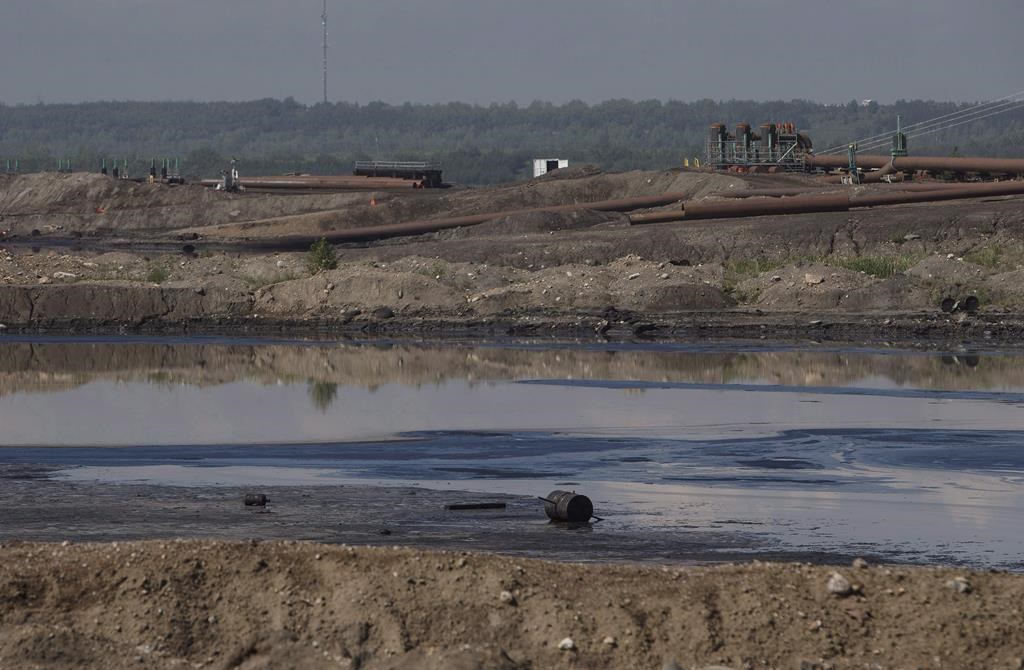Support strong Canadian climate journalism for 2025
The Alberta Energy Regulator says it is investigating after Suncor reported the discovery of dozens of dead birds at an oilsands tailings pond.
The regulator said in a post on its website Saturday that Suncor informed them late Friday afternoon of 32 dead waterfowl found at a tailings pond 29 km north of Fort McMurray at Suncor's Base Mine Site.
The post said the energy company found the birds during an oilsands bird-contact monitoring program survey.
It noted that "the state of the wildlife indicates that this may not be a recent event, but this is under review."
The post said Suncor has since advised it's also found a muskrat and a vole, both dead.
The regulator said an AER inspector "was immediately on site" and, in addition to checking bird deterrence systems, the inspector will "ensure mitigation strategies are in place."
"Collaboration between the AER, Suncor, Alberta Environment and Parks, and Environment Canada and Climate Change is underway to ensure that all safety, wildlife, and environmental requirements are met during the response to the incident," the AER post stated.
"We will continue to assess the situation closely and provide further updates as required."
Suncor spokeswoman Erin Rees said in an email the birds were found during one of the company's "regular, required checks." She said appropriate regulatory authorities have been notified.
"At the time of discovery, all bird deterrent systems at Base Plant were active. Our Bird Deterrent Program includes canons, radar and effigies. We have initiated an investigation," Rees said.
Incidents of bird deaths at oilsands tailings ponds over the years include 50 birds that landed at an Imperial Oil tailings area near its Kearl oilsands project in northern Alberta in May 2020. Imperial said at the time it believed it occurred in spite of deterrents because most of the natural water bodies in the area were still frozen.
In January 2019, Syncrude was fined more than $2.7 million after pleading guilty to environmental charges in the deaths of 31 great blue herons at one of its oilsands mines north of Fort McMurray in 2015.
Syncrude was also fined $3 million in 2010 after more than 1,600 ducks died when they landed on a tailings pond in 2008.
Earlier this week, Suncor Energy Inc. reported the release of six million litres of water from a sedimentation pond at its Fort Hills oilsands mine north of Fort McMurray that exceeded guidelines for sediment.
Suncor said it has stopped outflow from the pond and is studying the cause of the problem and how it affected water quality.
Timely notification of water releases from oilsands mines also became an issue earlier this spring.
Last May, Imperial Oil noticed discoloured water seeping from one of its tailings ponds that turned out to be groundwater contaminated by waste, but neither First Nations nor governments were notified about the problem until February after a second release from a catchment pond.
Three inquiries have since been called into that nine-month silence.
This report by The Canadian Press was first published April 22, 2023.




Comments
"A wake-up call to oilsands industry to ensure that all necessary measures are in place to prevent future wildlife tragedies"
How many "wake-up calls" does the oilsands industry need?
Ludicrous. Oilsands companies have turned the region into an ecological sacrifice zone. Oilsands mines obliterate the landscape, erasing habitat. Leaving a toxic legacy for generations. The whole enterprise spells ecological disaster.
"The tailings ponds sit on an important migratory bird pathway used by millions of geese, ducks, swans, loons and dozens of other species flying north in the spring and south in the fall.
"… The Peace-Athabasca Delta, located less than 80 km north of oilsands projects, is recognized as ONE OF THE MOST IMPORTANT WATERFOWL NESTING AND STAGING AREAS IN NORTH AMERICA, with more than 400,000 waterfowl having been recorded during spring migration. During fall migration, estimates have exceeded one million birds. In all, 214 bird species have been recorded on the delta, many of which pass over or near the oilsands regions."
"Tailings ponds a toxic legacy of Alberta's oilsands" (Toronto Star, 2015)
Chief Allan Adam: "We can hardly get a boat through the Delta, migratory birds don't fly over, the fish are diseased, and our people are sick."
Report of the Joint Review Panel: Teck Resources Limited: Frontier Oil Sands Mine Project
"We find that the project is likely to result in SIGNIFICANT ADVERSE ENVIRONMENTAL EFFECTS to wetlands, oldgrowth forests, wetland- and old-growth-reliant species at risk, the Ronald Lake bison herd, and biodiversity. The project is also likely to result in SIGNIFICANT ADVERSE EFFECTS TO THE ASSERTED RIGHTS, USE OF LANDS AND RESOURCES, AND CULTURE OF INDIGENOUS GROUPS who use the project area. The proposed mitigation measures have not been proven to be effective or to fully mitigate project effects on the environment or on indigenous rights, use of lands and resources, and culture."
If that's sustainable development, what does unsustainable development look like?
It's abundantly obvious that deterrent systems don't work.
Most wildlife incidents go unobserved and unreported. Night-time landings and sinkings go mostly unobserved. Visual deterrents (scarecrows) are useless at night. Birds get used to the sound cannons.
Oilsands companies aren't charged for killing birds and wildlife, but for failing to deploy (ineffective) deterrents. I.e., negligence. If the mostly useless deterrent systems are up and running, no charges are laid. Oilsands companies get a free pass to kill birds.
The tailings ponds are a death trap for birds and other wildlife. The Govt permits them, even though the law says otherwise.
"More research is needed on the impact of even brief landings; whether, for instance, the birds carry some contamination beyond the ponds and into the forest or to their nests." (Edmonton Journal)
"Millions of birds' lives lost: report
"Based on recent research that looked at waterfowl landing rates on ponds, including those with deterrent systems, Wells thinks annual bird mortality from landings and drowning in the oily water in current tailings ponds could range from more than 8,000 birds to well over 100,000. A doubling of tailings ponds would increase projected annual bird deaths to between 17,000 to 300,000 individuals, the report says." (Edmonton Journal)
"The federal and AB govts are reviewing better ways to keep birds off toxic tailings ponds in the oilsands region after new research revealed thousands of landings of migrating birds.
"…Both the federal and provincial environment departments are reviewing the groundbreaking study by University of AB biologist Colleen Cassady St. Clair whose research revealed an estimated 200,000 bird landings annually which would result in more than 1,000 fatalities.
"The study puts govts on the spot because under the federal Migratory Bird Act, it is illegal to allow birds to land in toxic substances.
"It's now clear company efforts to deter birds with long-used noise cannons and other measures are not completely effective and landings are fairly common.
"…Timoney also said the U of A study likely underestimates the number of dead birds in the tailings ponds, possibly by a factor of five." (Edmonton Journal)
Just another wake-up call as the oil & gas sector continues to operate unchecked by the Alberta Energy Regulator and ignored by the UCP.
Nothing will ever change as long as the UCP are in power.